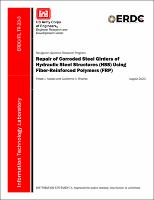Please use this identifier to cite or link to this item:
https://hdl.handle.net/11681/47404| Title: | Repair of corroded steel girders of hydraulic steel structures (HSS) using fiber-reinforced polymers (FRP) |
| Authors: | Acosta, Felipe J. Riveros, Guillermo A. |
| Keywords: | Carbon fiber-reinforced plastics Hydraulic structures--Maintenance and repair Steel, Structural--Corrosion Steel, Structural--Maintenance and repair |
| Publisher: | Engineer Research and Development Center (U.S.) |
| Series/Report no.: | Technical Report (Engineer Research and Development Center (U.S.)) ; no. ERDC/ITL TR-23-3 |
| Abstract: | Although steel hydraulic structures have a protective system to prevent corrosion, this type of deterioration will eventually occur due to the constant exposure to harsh environmental conditions. There are several techniques that can be implemented to repair corroded steel structural elements. This report presents a numerical study to evaluate the mechanical behavior of corroded steel girders used in hydraulic steel structures and to evaluate several carbon fiber–reinforced polymers (CFRP) layups to repair them. The girders were modeled as simply supported with four-point loading boundary conditions. The corrosion deterioration was modeled as loss in section as 10%, 25%, and 40%. The effectiveness of the deterioration was established based on the level of stresses at the steel compared with the undamaged condition after it is strengthened with CFRP. It was found that CFRP repair is more practical for reducing the stresses at the steel in the shear dominated zone if deterioration is below 25%. At the tensile dominated zone, CFRP is effective for reducing the stresses for deterioration below 40%. |
| Description: | Technical Report |
| Gov't Doc #: | ERDC/ITL TR-23-3 |
| Rights: | Approved for Public Release; Distribution is Unlimited |
| URI: | https://hdl.handle.net/11681/47404 http://dx.doi.org/10.21079/11681/47404 |
| Appears in Collections: | Technical Report |
Files in This Item:
| File | Description | Size | Format | |
|---|---|---|---|---|
| ERDC-ITL TR-23-3.pdf | 2.46 MB | Adobe PDF |  View/Open |